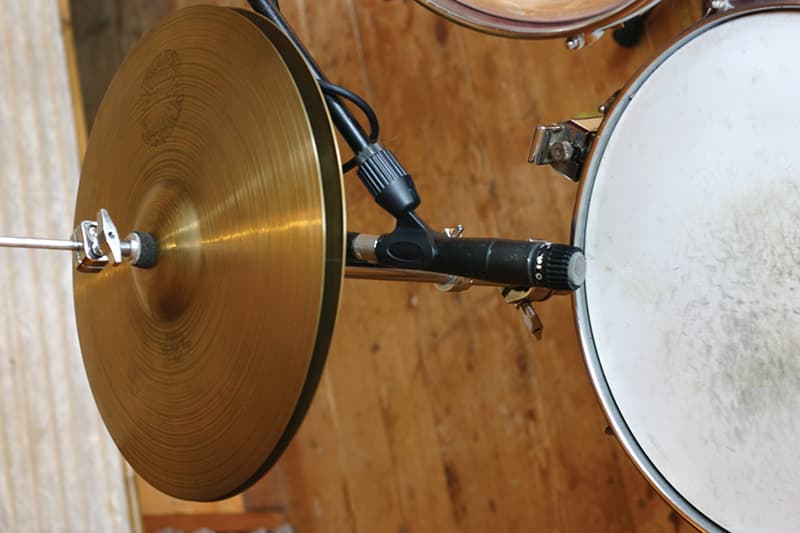
Production Fundamentals: Recording Drums
One of the trickiest engineering tasks in the studio would have to be the recording of drums. One of Australia’s finest recording engineers, Paul McKercher, offers some salient advice to help us capture the power and majesty of this crucial instrument.
Text: Paul McKercher
Ever since Geoff Emerick boldly placed his microphones within sniffing distance of Ringo’s Ludwig drumkit for The Beatles’ ‘White’ album, it’d be fair to say that the recording of drums hasn’t changed very much. With notable exceptions, such as the brilliant Tchad Blake and his dummy head binaural techniques and various lo-fi adventures with just two well-placed microphones, the practice of close miking each element of the kit for impact and adding a few room mics for ambience remains a staple.
While being able to pull a great drum sound is the mark of a recording engineer, I’d challenge the notion that it’s all about engineering technique. Other factors have a greater bearing on the outcome, these being: the quality of the kit itself (which is obvious enough), the way in which it is hit (a subject beyond the scope of this article) and the sonic character of the room the drums are recorded in. In fact, any time your mics are more than 10cm away from an acoustic sound source the sound of the room becomes an important consideration – more on that later. What you’re after is a good recording of a good drum kit and it’s hubris to expect that a great engineer with all manner of top-notch equipment can turn a crummy kit into something that turns heads.
KIT & KABOODLE
So what makes a drum sound good? Now, while one person’s floor is another’s ceiling and good sound is a question of taste and context, there are a few indisputables that contribute. For instance, the drum should be as round as manufacturable and the bearing edge (where the wood meets the skin) should be dead flat. All good in theory, but the mechanics of mounting a drum can conspire to distort its shape. Bass drum-mounted toms are the worst offenders as the entire weight of the tom is transferred onto the mounting post and into the bass drum. With wood being more flexible than metal, the drum and, in particular, the bearing edges take on a less than ideal shape. You can check this by supporting some of the load with your fingers under the rim while you hit the tom. Be prepared to be unpleasantly surprised at the loss of tone and sustain. Hence rim mounting systems are a popular panacea and work effectively to spread the load more evenly around multiple points on the rim, allowing the shell to vibrate freely and happily and, as a bonus, they take the weight of the tom off the bass drum, improving its resonance.
More important, though, is good tuning and, again, while being a matter of taste, it’s worth noting that a well-tuned drum is much, much louder than a poorly tuned one – invaluable if you want to hear the drums above the cymbals in your room mics and imperative in being sure there’s a lot more snare in your snare mic than hi-hat spill. A common question is ‘how do you keep hi-hat spill out of snare mics?’. Good tuning helps considerably, but pointing the back of the snare mic at the hi-hat (if there’s enough room) will also give you a few more dB of hi-hat reduction. Better that than using a noise gate or even Sound Replacer software – these approaches can be very effective, although they can throw up questionable results, particularly on rolls. I’m a great believer in tuning drums to the song, which is not to say the drums should necessarily be tuned to a triad based on the song’s key – sometimes dissonance works – but I’ll try to get the drums to sit musically within the harmonic framework of the song given that drums are more than simple, atonal percussion. Personally, I don’t have the necessary expertise to tune drums so I rely on the drummer or hire in a drum doctor. I do, however, know that gaffa tape all over a drum skin is a bad sign. If the drum is round, the bearing edge flat and the skin in good condition, those unwanted rings should be able to be tuned out. A little bit of dampening is okay but if the skin requires more than one piece then there’s something wrong with the skin or the drum. If a shorter, deader sound is required, try using a thicker skin or the old tea towel trick, where the said kitchen item is placed over part or all of the skin. Drum gel is a great accessory too, and works better than tape as its edges don’t lift and flap around, which a sharp pair of ears will hear. Failing all this, hiring a good kit might be a good idea and if it saves some stuffing around while in an expensive studio – at $100 a day, it’s paid for itself in an hour.
For those who are interested, here is my standard drum mic setup. Mics are listed in order of preference.
Bass drum inside
Sennheiser MD421, Beyer M88, AKG D112
Bass drum outside
Neumann U47fet, AKG D112
Snare top
Shure SM57, AKG C451+10dB pad
Snare bottom
AKG C451+10dBpad, Shure SM57
Hi-hats
AKG C451+10dBpad, Neumann KM84
Toms
Sennheiser MD421, Neumann U87
Overheads
Coles 4038 ribbon, Neumann U67/87, AKG C414
Room
AEA, Coles or Royer ribbons, Neumann U87
For preamps I favour old Neves, or if I need something a bit faster for more snappiness, I’ll use APIs. I’m sure there are plenty of other usable alternatives out there, but like all tradesmen, I’ll go for the tool that’s close to hand and the gear listed above is commonly found in good studios, with the exception, perhaps, of the ribbon mics. A quick note about ribbons… they are very sensitive and don’t like wind blast, so for this reason and the fact that they have very strong magnets in them and attract iron dust from the air, you should put a cover on them when they aren’t in use or are being moved about. This will prolong the life of the ribbon by some years.



YOU PUT THE MIC WHERE?
Now to mic placement and the lost art thereof. Before EQ circuits were found in recording consoles, engineers chose the tone they wanted by using the appropriate mic and placing it correctly, good engineers still do… closer for more low frequency, further away for less, just for starters. Even a cursory examination of mic angles and distances will tell that there is a world of tonal variations available – as much as EQ will provide and without the distortion and phase problems associated with EQ circuits. So get off your proverbial, get into the recording area and start moving those mics around; explore and discover. Become a recording engineer not just a knob twiddler (such a disagreeable term). Here are a few pointers. When pointing a mic at a drum, the more parallel the mic is to the skin, the more fundamental frequency it will pick up. Move it to a higher angle of incidence and you will hear more overtones. If you want more bottom end, instead of diving for the nearest EQ, move the mic closer. That way you won’t be EQing the spill as well, instead you’re only adding low frequency to the instrument (e.g. a snare drum) closest to the mic, the spill of other more distant elements won’t sound any different. The reason low frequencies increase with decreased distance is explained in the side bar and is called proximity effect, as powerful a tool as EQ.
THE SNARE
A lot of sound comes off the rim of a snare drum, especially if the drummer is hitting rimshots, so place your mic in a bit from the rim if you want to attenuate that sound, or nearer to it if you want to hear more ‘clang’ in a metal snare and ‘knock’ from a wooden one. A mic on the bottom of the snare is often an afterthought but with careful placement it can sound quite good. The trick is not to mic the wires directly but to point the mic at a spot on the skin about 10cm away from the wires. By doing this you’ll still get plenty of brightness from the wires but without the brittleness. As far as sympathy rattles from snare wires go, I don’t bother to gate them out. To my ear it’s part of the natural sound of a kit so long as the wires are correctly tensioned and the bottom skin is well tuned. Neither do I use gates on toms; if they are well tuned any sympathy rings can sound quite natural. However, if they do need attenuation when they’re not being played, a fader ride is the better option since most noise gates are unpredictable, inaccurate and have dubious sonic integrity.
TOMS
Similar placement principles apply when miking the toms. For instance, rather than adding a lot of treble to a tom and bringing up the splashy spill of nearby cymbals, try a steeper miking angle, pointing the mic at 90˚ to the skin and aiming it directly at the rim will give you a bright slappy sound, great for cutting through edgy guitars; and if you want more body and tone, try placing a mic in a similar position on the bottom skin as well. Ideally it should be the same model as the one on the top. The trick to this technique is that you plug both mics into an easy-to-make Y-cord combiner, which reverses the phase of the bottom mic and combines their outputs into a single mic line, saving you a mic pre, a track and keeps things simpler. For this to work well, close attention should be paid to the tuning of the bottom skin.



OVERHEADS
There are a few approaches to overhead miking; the first is where the mics are purely for capturing the cymbals. In this case the mics should be 30 – 45cm away from the cymbals and, importantly, should be directly above the bell. This is so, when the cymbal gets struck and seesaws on its stand, its bell keeps a constant distance to the mic and delivers a consistent, even sound. If the mic is pointing at the edge, any ‘see-sawing’ will give up and down levels as the cymbal edge moves towards and away from the mic. Bear this in mind, too, when miking hi-hats that are open and being vigorously belted.
Of course, not all drummers have just two conveniently placed cymbals, and if this is the case, try moving the mics higher so that they get a broader view and ‘see-sawing’ doesn’t become such an issue. The mics are now hearing more of the overall kit and should be chosen appropriately. Large diaphragm condensers and ribbon mics are better for this application since they translate the sound of the drums nicely as well.
Placement should be such that all the cymbals are captured evenly but also that the snare is in the centre of the image with the overheads panned hard left and right. This achieved by spacing the two mics equidistant from the snare drum (holding the end of a mic cable to the centre of the snare drum and measuring the distance to each overhead is an easy way of going about this). For my money, ribbon mics make great overheads since modern ones have a more articulate midrange than condensers. A ribbon element is generally much lighter than a condenser diaphragm and as a result has better transient response and, while not being as bright as a condenser, a ribbon mic in good condition sounds more ‘real’ to my ear than a condenser and it’s in the midrange that true detail is important. Again… ceilings and floors.
CLICK TRACKS
There’s a myth surrounding the use of click tracks that says that they make a track sound stiff. Baloney! All You Need Is Love, a live broadcast by The Beatles to an audience of millions, was done to a click track, which came from a tambourine on a tape loop. Stiff? Hardly. It is in fact a gorgeous performance of one of the most perfect songs in a 7/8 time signature ever written. A clue to its success lies in the fact that it was a tambourine and not a sharp, abrasive cowbell (which at first would seem the better choice). Using a more diffuse sound with some length and a gentle attack like a tambo or a shaker allows the drummer to move around the beat a bit, something all drummers naturally do. Also, programming 16ths rather than 8s or 4s lets the drummer hear some tempo guidance throughout the bar and not just in the places where they’re hitting the kick or snare, which, if you’ve only programmed a click in 4s, they probably won’t hear anyway, unless they’re flamming with it – whereupon their confidence will disintegrate and they will immediately stiffen [Here, here! – Ed.] – or the click is so loud that it’s bleeding into all the drum mics, distorting the headphones and giving the drummer a headache. If you choose to use a click and are concerned that the tempo has no move and sway, use a Midi instrument and write a tempo track with tempo changes to suit. Or don’t use a click track; it’s horses for courses. It’s worth thinking of a click track as a tempo guide rather than an absolute arbiter of time.
The fact is, the phase relationships of all these mics will never be exactly ‘right’ or ‘wrong’ because perfect acoustic phase simply doesn’t exist





PHASE
There’s an adage that was taught to me by an old bloke in a dusty lab coat during my 10 years in ABC radio – that you should never use two mics where one will do. The reason being that sound coming from Point A will never arrive at two equidistant points at exactly the same time. The result being phase cancellations and incoherencies. This is good advice and applies well if miking a sound source that emanates from a small area; a voice for instance. A drum kit is a multiple sound source and so, with up to a dozen microphones placed near it, phase problems are a given, with spill from any one element getting into every mic and affecting the tone and imaging of all other elements. The fact is, the phase relationships of all these mics will never be exactly ‘right’ or ‘wrong’ because perfect acoustic phase simply doesn’t exist. Just as when you flip the phase of your bottom snare mic to make it more in phase with the top snare, the same needs to be done with every other mic on the kit. Now, I know the whole issue of phase is boring but there’s no point EQ’ing anything until you’ve gotten the phase of all those mics ‘right’. Here’s how I do it.
Starting with the snare mic’s fader open and panned centre, bring up another mic as well, say, the bass drum. While the snare and bass drum are being played, flip the phase button on the bass drum channel (or mic pre) and listen to the result. The position that gives more bottom end is the correct one. If there is no change in low frequency content, pan the snare left and the bass drum right and with your head between the speakers (or in headphones) listen to the width of the image while, again, toggling the phase button on the bass drum. The narrower image is the correct one. Still can’t pick it? This probably means that the phase relationship between the two mics is equally as wrong as it is right, and, if it comes to this, you’ll just have to make a judgment call on which sounds better.
Now close the bass drum fader and repeat the process with every other fader for each mic on the kit, using the snare fader as your phase benchmark. When you get to the overheads, there should be a fairly obvious cancellation/reinforcement in the bottom end of the snare. If not, move the overheads up or down (maintaining equidistance with the snare as described earlier) until there is. This will really help the snare sound along once all the mics are open. The whole process should take no more than 10 minutes and, once done, you are ready to start EQing.
AMBIENCE MICS
Close mics provide impact but room mics are used to give length to the sound. They create a sense of space and, if well placed in a good-sounding room, sound infinitely more interesting than an electronic reverb. If the kit itself doesn’t ‘throw’ good sound into the room or the room sounds uneven, the room mics will probably be useless in a mix, so good tuning is vital. To help with ‘throw’, place some reflective surfaces behind the kit or put the kit near a wall or in a corner of the room. How far the room mics are away from the kit will be determined by how big the room is, but also how much pre-delay you want. In a slow song where a massive sound is called for, go for distance, but in a faster tune (where there simply isn’t space in the arrangement for a thunderous drum sound), get the mics in closer and perhaps put some blankets on the floor and walls to shorten the room’s decay time. Low frequency tends to congregate along surfaces and in corners, so if you want more bottom end, place the mics near these – even face the mics at the walls or floor to get some more early reflections. If it’s bright, splashy ambience you’re after, send them skywards. Having a wander around the room while the drummer is playing and using your ears will be a good guide to where to place your ambience mics and there are no rules. On occasion I’ve placed a room mic inside a bucket near the kit to good effect.
There’s nothing new or radical in anything I’ve written in these pages and the methods I use are commonplace. There is no magic bullet to making great recordings; the one thing that does vary greatly between engineers is their ability to hear ‘inside’ the sound. So, as always, listen deeply. Analyse your favourite records, train up your concentration span, take pride in your achievements and learn from your blunders. Send any kooky recording ideas, faint praise or savage attacks to me: [email protected]
















RESPONSES